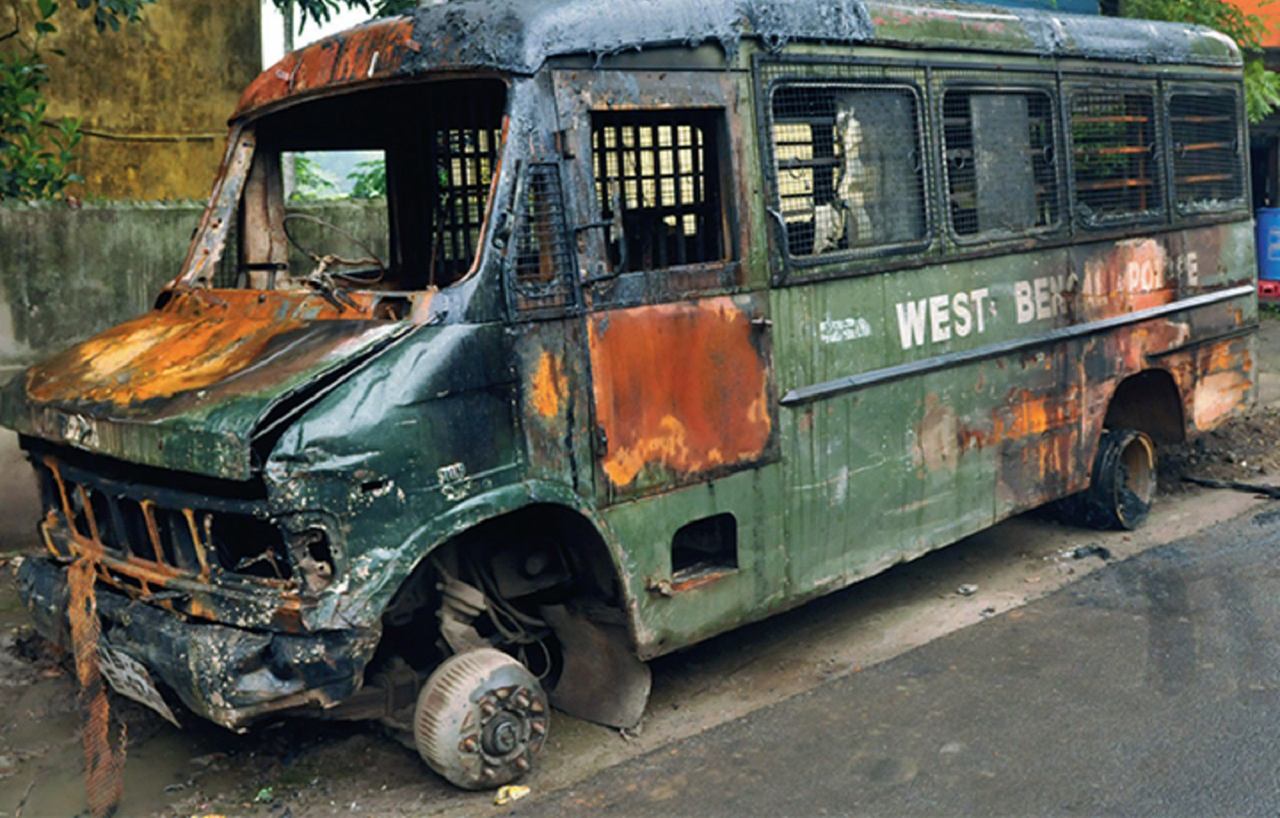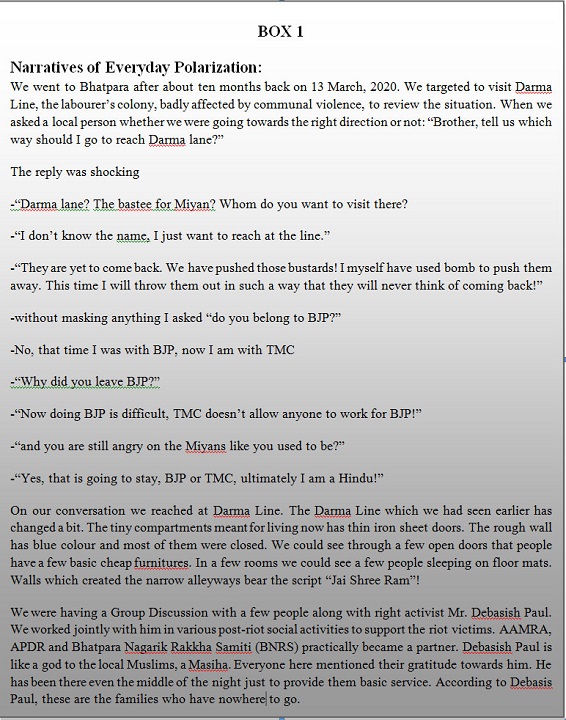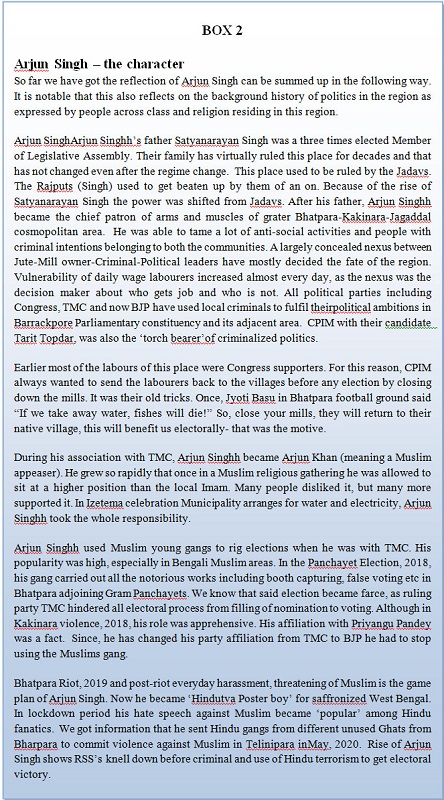Bhatpara, is one of the most prominent names in the existing map of communal conflicts in West Bengal. Over the years, through various published and unpublished studies, AAMRA has noted that settlements near the Jute-mills along the river Hooghly are quite prone to communal polarisation and identity-led conflicts. This is a study of exploring identity consolidation in and around Bhatpara region through a series of fieldworks. This study unravels the complex politics-identity interface through intensive study of facts and artefacts. We have intentionally kept some of the raw data in the report, as there are more inconclusive questions than answers, as to what actually happened in Bhatpara over the years. There are multiple narratives, perspectives and dimensions to each of the conflicts that have rocked the political and everyday spectrum of West Bengal. This is the concluding part of the report. The links to the earlier parts are given at the end.
Post riot dynamics:
We again visited Bhatpara in May 2020. We reached Darma lane. It was about ten months since we had last visited Bhatpara. It was difficult to locate the exact place and when we asked a 30 year old man, he said “You want to go to the Miyan (Muslim in derogatory sense) slum… they are not there. We have thrown them out. We have bombed them away. This time we made them flee to save their lives.” We asked him “Are you a BJP worker?” His reply was equally straight. “I was with BJP but now I am with TMC, these people do not allow us to work for BJP. But we still hold our strong disgust for the Miyans. Whichever party I work for, I am a Hindu!”
Box 1
In our extensive field study for over a period of one year, we got some new findings which are an indication that the gap between the two communities had broadened more than before. Communal violence can erupt at any time on any pretext.
Muslims are prohibited
Many Muslim workers at different Jute Mills are being deprived from getting work on regular basis. In our repeated visits, youths belonging to Muslim labour family disclosed their bitter experiences.
Statement of Mehtab Alam (name changed) from ward number 13 of Bhatpara Municipality
We got information that Company (Kankinara Jute Mill) is going to recruit some people for posts like accountant (knowing Tally, GST), computer data entry operator etc. But when we made contact, they refused to tell us anything by saying that there are no such vacancies. Later, we got information that recruitment has been done. They recruited non-Muslim candidates. It is a fact that there was no official announcement about it, but the truth is that all the Jute Mills have stopped giving new jobs to Muslims.
Religious and Politically Biased Compensatory Steps
Only Rs 25000 was given to each victim as relief by the Government of West Bengal. But we heard grievances from many about inequality in distribution of relief, compensation and jobs. Shyamoli Shaw, widow of Prabhu Shaw, who was shot dead by the police in an encounter received nothing (we have added our interaction with her in the ‘victim’s testimony’ section).
The policy of ‘Job for victim’s family’ reveals another form of discrimination based on political affiliation and victim’s religious identity. If Arjun Singh and his son’s presence and support for almost every Hindu victim family is one side of the coin, the other side shows TMC’s support to almost every Muslim victim. BJP captured Bhatpara Municipality as soon as Arjun Singh shifted from TMC to BJP. Temporary job for elder brother of deceased Ram Babu Shaw in Bhatpara Municipality and State Government service for the elder son of the deceased Md. Halim exemplifies this religious division in compensatory policy starkly.
Major problems
Through a Group Discussion we could unearth some of the major problems that these people are facing. Their problems are documented as below:
School:
Because of the loot during riots, most of the kids lost all education related materials. Starting from books to identity cards to their school dress, everything was gone. Many families could not send their children to school for about eight to ten months. Since the exams are approaching they have started attending the school. A few organizations have taken initiative to provide some basic aids like text books and exercise books. Almost everyone we talked to couldn’t pay the school fees. Paying school fees is nearly impossible for them. A few families even took out loans to pay the fees.
Electricity bills:
Bills for ten months are pending. Because of their repeated request, the electricity department didn’t snap the connection, but paying the dues of ten months even in installments is a huge burden. Also, the longer they keep bill unpaid, the larger the fine is!
LPG connection:
During the loot nearly every family has lost their cooking gas cylinders and none has the capacity to buy a new cylinder. They are using wood scraps as fuel. Some of them even couldn’t afford that, they depend on the collected leaves and woods. In a cramped slum, using such firewood entails a considerable risk. Needless to mention that Kerosene selling at Rs.70-80 per litre is a luxury to them.
Compensation:
Immediately after the riots, many promises were made but none of them kept. The Office of the Block Development Officer has distributed Rs. 25000/- to about 100 families from among the 200 affected. Even after submitting all the documents, the 100 remaining families are yet to get the compensation.
Mr. Debasis Paul, a local human right activist, said, “The Police Officers of the Kankinara Police Station have been quite casual in dealing with the issue and completing the investigation. Those who received the compensation had to get it through a painstaking process. Those who are still left out, I am doubtful if they will ever get the compensation! These families blame the fact that they do not have proper documents needed to get the compensation.”
Health related issues:
No one here can get health care even in exchange for money. Several NGOs have organized free medical camps. It is seen that for organising one such camp they need about Rs. 2500 to 3000. Because of fund shortage health camps can’t be organized for the last couple of months.
Helplessness:
Local people have seen important leaders like Gopal Rawat leading the riot. Consequently, they can no longer depend on anyone. That time Gopal Rawat was with BJP, at present he is with TMC. It is alleged that in order to escape from a number of cases lodged against him, he has changed political camp. No has stood beside them. If they go with any problem to Gopal Rawat, he simply ignores them. Celebrities like film directors Ms. Aparna Sen, theatre personality Kaushik Sen and activists like Teesta Shitalabad came to meet them, but their own municipality councillor Mr. Maqsud Alam has never tried to know how they are living. TMC has made Maqsud Vice Chairman of the Municipality just to keep hold on the local Muslim electorate. Firhad Hakim, Minister, Government of West Bengal came once.
Anxiety:
All of them reported that when they go out of this place they are teased by the outsiders. Even when the go to fetch water they are teased. Muslim women are threatened, “Last time we have looted goods, this time we will ‘loot’ (rape) you.” Even kids are told “now we will kill you”. They are told “do hazaar unnish aadha finish/ do hazar bees pura finish” (You were half-finished in 2019 and in 2020 we will finish you completely). “We don’t reply to such taunts!” the Muslims said. They repeatedly requested for police protection but nothing happened. Rather, the police told us not to go out frequently. On the day of Holi festival, fearing violence, the Muslims submitted a mass petition for police posting. Police provided protection on 9 and 10 March, but that too only during the daytime. There was no protection during the night.
Hints from the Hinterland
All sorts of hindrances stood in our way of making this report. We got information from various sources, we can’t disclose their name, designation etc. it is against our professional ethics. The hints we got are alarming, indications we gauged are clear, ‘polarization is complete and the chance of riot is there at any time’.
Manufacturing Riot to grab land
We can’t ignore the conspiracy to grab land by manufacturing riot. Because the adversely affected ward number 8 of Bhatpara Municipality is the hub of this industrial area. Headquarter of Bhatpara Municipality, Bhatpara Police Station, big markets and big business houses are situated here. Some sections of Jute mill labourers got quarters from their grandfathers, who are no more today. Many others got quarters from the retired labourers. Riot and mass displacement of Muslim household gave an opportunity for the Mill owner to vacate those labour quarters. Mill owner’s strategy is to capture this type of quarters; they targeted abandoned quarters of the Muslim labourers in a systematic way.
Tamanna Parvin and Shahabuddin Monsuri, two young victims of the riot also hinted at the ploy to capture the quarters of Muslim settlers. They suspect a conspiracy in this by the Mill owner along with the Hindutva forces. During our fact-finding work, we also got an anxious statement from Imtiaj Ali, son of deceased Mustaq. Imtiaj mentioned that a large scale planning of ‘Muslim free’ Bhatpara is going to materialize.
Jute Mill owner-Miscreant-Party nexus
Owners of Jute Mill always are in favour of the ruling party. Local miscreants are the frontline force of the political parties. Booth capturing, indiscriminate bombing during elections has become synonymous with Bhatpara. ‘We know animosity among political parties, but here, all are partners of the wine-party and cocktail party, sponsored by the mill owners’, told a veteran trade unionist. Their atrocities against common labourers are a common feature. Mill owners and trade unions do not protest against any illegal activities. Here all Mill owners violate labour laws, they seldom pay their portion of the mandatory contribution to the Provident and Gratuity Fund. Their hobnobbing with the ruling party is based on ‘give and take’ policy.
Criminalization of Politics and Hindutva
From 2016 to 2020, our incessant field study on Bhatpara and its adjoining areas, gave us some incisive information on its demography. Our fact-finding (Conflict area study-4) on communal violence at Hazinagar and Naihati in the year 2016, the adjoining area of Bhatpara, gave us few insights like:
- ‘TMC at daylight but RSS or Jamat at Night’
- ‘All roads go to Rome’, so all Ram Navami rallies gave political incentives to BJP.
- Rioter and victims, all are TMC supporters in the first stage, but in the later stage, Muslim means TMC and Hindu means BJP.
Box 2
At Barrackpore Subdivision criminals always played a pivotal role in power politics. From politicization of criminals to criminalization of politics, that we have noticed in the last decade, but now it is communalization of politics and crime that is happening.
Instead of conclusions:
Bhatpara communal riot is a complex, multi-layered and historically specific phenomena, hence, we are not in a position to make any conclusive comment on it. However, it is important to reflect on a few important dimensions of the conflict.
a. There is a deep-seated communal sentiment nurtured over the years. The magnitude and continuation of conflict makes it clear that local people have actively participated in the riot.
b. It is needless to mention that one of the most prominent epicentres of identity-politics viz-a-vis riot in West Bengal is now Bhatpara-Kankinara area. People are clearly pointing fingers to the TMC-BJP conflict along the religious identity fault lines. It has a lot to do with Arjun Singh’s BJP affiliation and TMC’s selection of Madan Mitra, who allegedly used goons from the Kamarhati area – his stronghold.
c. The political control here has less to do with deliberations and conversations and more to do with arms, muscles and conflicts. These conflicts could ultimately consolidate the Hindu majority electorates even at places like Tina Gudam, where Hindus and Muslims apparently shared the same common space for keeping Tazia and placing Hindu Idols.
d. It is difficult to comprehend what makes people hate each other while they share much of the common fates including the mega-toilets, bathing place, or the same factory shed where they work together. However, years of criminalisation of politics, nexus between mill management and labour-contractors, extreme poverty are symptoms of what resulted afterwards.
e. Through a long term process of constructing the notion “Hindu khatre mein hain”, there has been a percolation of fear psychosis among the majority community, who didn’t shy away to openly express hatred towards the Muslim ‘other’. Statements like Muslims possess choppers for Qurbani, or the vivid description of decapitated body of Lala Chowdhury with an added emphasis that this must have been done by some Muslim because they are expert butchers reflect such constructs.
There are several unresolved issues like how Rajesh Shaw did lose his hand? Why did people in large numbers enter inside the jute mill to take shelter late in the night when TMC allegedly launched an attack? Whether the goons were actually wearing police uniforms? And so on. It is reasonably clear that even after our several years long study, we could only penetrate the outer layer of the complex and multi-layered chaotic case of Bhatpara.
Bhatpara has been central to AAMRA’s activities for quite some time now. We have been reaching out to people from different spheres like researchers, activists, noted intellectuals, psychologists and lawyers. We have been fortunate enough to get several feedbacks from them over the years. Needless to mention, restoration of peace is one of our major concerns, and while doing so, we however also looked at the legal dimensions of the issues. We believe that a Judicial Commission should be constituted by a sitting Judge of Calcutta High Court to enquire about the communal riots at Bhatpara and its adjacent areas with specific references. Local administration should encourage registering of all the offences which appeared to be cognizable in nature. More FIRs are needed, so that an independent investigation agency can probe the complaints in accordance with law. To minimize tension in the locality, round the clock police patrolling should be introduced in communally tensed areas, particularly, in the areas where minority communities have strong presence. The entire Bhatpara area should be searched by police thoroughly and all arms, weapons, explosive substances and the allied materials etc. should be confiscated.
To read the earlier parts click on the links below :
Bhatpara Fact-Finding Report (2018-2020) – Part 1
Bhatpara Fact-Finding Report (2018-2020) – Part 2
Bhatpara Fact-Finding Report (2018-2020) – Part 3
Bhatpara Fact-Finding Report (2018-2020) – Part 4 (Victims’ Testimonies)
Bhatpara Fact-Finding Report (2018-2020) – Part 5 (Testimonies of Children and Youths)
……………………………………….
Conflict Area Study -8
West Bengal: Post-Ramnavami Riots
Series – I
Bhatpara Fact-finding Report (2018-2020)
By AAMRA ek Sachetan Prayas Forum
Date of Publication- 1 August, 2020
Team Members-
Sushmita Roy Chowdhury, Shamindra Sarkar, Tutun Mukherjee, Mohit Ranadip, Faruque Ul Islam, Subha Protim Roy Chowdhury, Suman Nath, Amitava Sen Gupta, Akash Bhattacherya, Promod Gupta, Debasish Paul, Sandip Sinha Roy, Vijay Rajak
Photographed by
Faruque Ul Islam, Suman Nath
Edited by
Suman Nath, Subha Protim Roy Chowdhury
Published by
Mohit Ranadip
On behalf of AAMRA EK SACHETAN PRAYAS FORUM (AAMRA-An Assemblage of Movement Research and Appraisal), 41/1 N.C Banerjee Road, Hooghly-712222, West Bengal, India.
Phn no- 8697095776, 9433879158, 8820852054
Email- aamrasachetan@gmail.com, Blog- aamraeksachetanprayas.blogspot.com
Website- www.aamrabharatbarsha.com , Facebook- http://m.facebook.com/aamra.eksachetanprayas.3
Copyright disclaimer
© 2020 AAMRA EK SACHETAN PRAYAS FORUM
The right of AAMRA EK SACHETAN PRAYAS FORUM to be identified as author of this work has been asserted by it in accordance with sections 77 and 78 of the Copyright, Designs and Patents Act 1988.
All rights reserved. No part of this report may be reprinted or reproduced or utilised in any form or by any electronic, mechanical or other means, now known or hereafter invented, including photocopying and recording, or in any information storage or retrieval system, without permission in writing from AAMRA EK SACHETAN PRAYAS FORUM.
Declaration
This report has been prepared by using standard social-scientific methods. The editors and fieldworkers have tried their best to present raw data and show the mechanism of arriving to each of the conclusions. The primary aim of this report is to present facts and derive issues out of them. We have kept personal information secret in so far as we are being requested by the informants.




